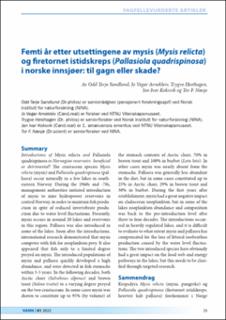| dc.contributor.author | Sandlund, Odd Terje | |
| dc.contributor.author | Arnekleiv, Jo Vegar | |
| dc.contributor.author | Hesthagen, Trygve H. | |
| dc.contributor.author | Koksvik, Jan Ivar | |
| dc.contributor.author | Næsje, Tor | |
| dc.date.accessioned | 2022-11-23T07:11:26Z | |
| dc.date.available | 2022-11-23T07:11:26Z | |
| dc.date.created | 2022-04-01T09:52:17Z | |
| dc.date.issued | 2022 | |
| dc.identifier.issn | 0042-2592 | |
| dc.identifier.uri | https://hdl.handle.net/11250/3033518 | |
| dc.description.abstract | Krepsdyra Mysis relicta (mysis, pungreke) og Pallasiola quadrispinosa (firetornet istidskreps, heretter kalt pallasea) forekommer i Norge naturlig i noen innsjøer på Østlandet. Etter utsettinger i regulerte innsjøer i Midt-Norge på 1960-70-tallet forekommer mysis eller begge arter nå i ca. 20 innsjøer. Hensikten med utsettingene av mysis var å forbedre næringstilgangen for aure og røye i regulerte innsjøer. Pallasea fulgte i noen tilfelle «som nissen på lasset ». Kort tid etter at utsettingen hadde skjedd viste forskning at mysis er en viktig predator på vannlopper og dermed en næringskonkurrent til røya. I tillegg virket det som om røya i liten grad spiste mysis. Etter utsettingene etablerte begge arter raskt bestander, og etter tre-fem år ble de påvist i fiskemager. Både aure og røye utnytter i ulik grad mysis og pallasea. I enkelte innsjøer utgjorde mysis på noen tidspunkt opptil 95% av mageinnholdet hos røya, opptil 70% hos aure og opptil 100% hos lake. I andre tilfeller var derimot mysis av svært liten betydning. Pallasea viste seg å være noe mindre viktig som fiskediett, men utgjorde likevel i enkelte tilfeller opptil 25% hos røye, 29% hos aure og 30% hos lake. Mysis hadde stor effekt på planktonsamfunnet, særlig vannloppene, men etter flere tiår ser disse i enkelte innsjøer ut til å ha stabilisert seg på omtrent samme nivå som før utsettingene. Fordi utsettingene skjedde i hardt regulerte innsjøer, er det vanskelig å vurdere hvorvidt mysis og pallasea har kompensert for tapt bunndyrproduksjon. Etableringen av disse to artene har hatt stor effekt på energistrømmen i innsjøene, noe som kun kan belyses gjennom målrettet forskning. | en_US |
| dc.description.abstract | Introductions of Mysis relicta and Pallasiola quadrispinosa in Norwegian reservoirs: beneficial or detrimental? The crustacean species Mysis relicta (mysis) and Pallasiola quadrispinosa (pallasea) occur naturally in a few lakes in southeastern Norway. During the 1960s and -70s, management authorities initiated introduction of mysis to nine hydropower reservoirs in central Norway, in order to maintain fish production in spite of reduced invertebrate production due to water level fluctuations. Presently, mysis occurs in around 20 lakes and reservoirs in this region. Pallasea was also introduced in some of the lakes. Soon after the introductions, international research demonstrated that mysis competes with fish for zooplankton prey. It also appeared that fish only to a limited degree preyed on mysis. The introduced populations of mysis and pallasea quickly developed a high abundance, and were detected in fish stomachs within 3-5 years. In the following decades, both Arctic charr (Salvelinus alpinus) and brown trout (Salmo trutta) to a varying degree preyed on the two crustaceans. In some cases mysis was shown to constitute up to 95% (by volume) of the stomach contents of Arctic charr, 70% in brown trout and 100% in burbot (Lota lota). In other cases mysis was nearly absent from the stomachs. Pallasea was generally less abundant in the diet, but in some cases constituted up to 25% in Arctic charr, 29% in brown trout and 30% in burbot. During the first years after establishment, mysis had a great negative impact on cladoceran zooplankton, but in some of the lakes zooplankton abundance and composition was back to the pre-introduction level after three to four decades. The introductions occurred in heavily regulated lakes, and it is difficult to evaluate to what extent mysis and pallasea has compensated for the loss of littoral zoobenthos production caused by the water level fluctuations. The two introduced species have obviously had a great impact on the food web and energy pathways in the lakes, but this needs to be clarified through targeted research. | en_US |
| dc.language.iso | nob | en_US |
| dc.title | Femti år etter utsettingene av mysis (Mysis relicta) og firetornet istidskreps (Pallasiola quadrispinosa) i norske innsjøer: til gagn eller skade? | en_US |
| dc.title.alternative | Introductions of Mysis relicta and Pallasiola quadrispinosa in Norwegian reservoirs: beneficial or detrimental? | en_US |
| dc.type | Journal article | en_US |
| dc.type | Peer reviewed | en_US |
| dc.description.version | publishedVersion | en_US |
| dc.subject.nsi | VDP::Zoologiske og botaniske fag: 480 | en_US |
| dc.subject.nsi | VDP::Zoology and botany: 480 | en_US |
| dc.source.journal | Vann | en_US |
| dc.source.issue | 01 | en_US |
| dc.identifier.cristin | 2014447 | |
| cristin.ispublished | true | |
| cristin.fulltext | original | |
| cristin.qualitycode | 1 | |
